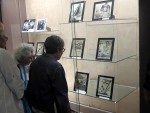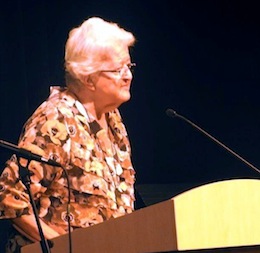“Palestinian Roots” by Ahmad Al Abid. (photo from cjnews.com)
Anyone visiting the student centre at York University in Toronto has been confronted since 2013 with a mural that some say incites violence and makes York a less welcoming place for Jewish students. The piece features a young man, pictured from behind, wearing a keffiyah with a map that includes an undivided Israel and Palestine and holding two rocks. Below him is a bulldozer, presumably Israeli and presumably preparing to overturn a farmer’s tree.
Recently, the mural has led one philanthropist to pull his support for the university and it has been taken up as a cause by Jewish and Zionist organizations.
The mural makes a not very subtle point. Israel is an aggressor, wantonly destroying Palestinian livelihoods for no reason. Palestinians are helpless Davids in the face of this Goliath, reduced to that most primitive of weapons, the stone. Beneath the image are the words “Peace” and “Justice” in several languages.
A picture, they say, is worth a thousand words and this is probably why the mural upsets so many people. With one glance, the viewer understands the anti-Israel narrative in all its simplicity. Israel is powerful; Palestinians are weak. Israel is aggressive; Palestinians are defensive. The map on the keffiyah, which erases Israel, is understood as a statement that the Jews stole this land from indigenous Arabs, whereas the same map, if employed for Zionist ends, would elicit cries of racism and genocide. Even the symbol of violence – the stones – can somehow be perceived as tools for “peace” and “justice,” given the nature of the enemy.
Since the mural was painted, the weapon of choice for the Palestinian lone wolf – if we can call someone incited to murder by their government and official media a lone wolf – has morphed from stones to knives. Videos and infographics teach Palestinians how to stab Jews most effectively.
Never mind all that. The world has an idée fixe, an unshakeable certainty, that Jews are powerful and, therefore, the Palestinians must be victims; they cannot be perpetrators or instigators. A new poll of French people says nearly 60% blame Jews to some extent for antisemitism. Antisemitism is uniquely identified as brought about by its victims, not its perpetrators. We wouldn’t have to be antisemitic, it seems, if only you would be less Jewish. Even the secretary-general of the United Nations is standing by his statement that Palestinians stabbing Jews is simple “human nature” in response to “occupation.”
The same poll also affirmed the view of Jews as powerful – and the attitudes of the French in this regard are probably not substantively different from those of other Europeans and some North Americans, varying more by degrees than by kind perhaps. Today, that power is measured in perceived wealth and access to political and cultural elites. When Jews were historically powerless in those conventional senses, they were attributed with supernatural abilities. Antisemitism adapts magnificently as required.
The perception of Jews as powerful is not only at the root of antisemitism but doubles as an impervious shield against challenging it. Consider: if Jews are powerful, then coming to their aid is an act of siding with the powerful against the oppressed. This belief is, at root, the very essence of the anti-Israel narrative now dominating much of the West, especially on the political left.
As always, this incarnation of antisemitism is a form of scapegoating, the projection of sins onto an empty vessel. As we are now almost congenitally conditioned to do, we acknowledge that Israel is not above criticism. No country is. Yet the proportion of global attention, the level of vitriol and the hyperbolic accusations against Israel are clear to anyone with a sense of proportion that this has limited relation to Israeli policies or anything else rational. The nature of the beast is that there have always been “good” reasons to attack Jews. Today’s reason is Israel.
Israel, of course, is a very powerful state, with a massive military for a population its size. If it wasn’t, its population would be dead or dispersed. Yet this still feeds the narrative of Jewish power and Palestinian weakness. If this is a battle between rocks and bulldozers, well, then, who wouldn’t side with the folks holding the rocks? This, in the end, is what the mural at York is telling its viewers. It is, actually, a magnificent synopsis of the mindlessness of the anti-Israel narrative, which strips all context from the conflict and ignores the fact that the perpetuation of violence is mainly a product of Arab maximalism and refusal to live in peace with a Jewish state. That’s a picture that is a little more complicated to paint.




